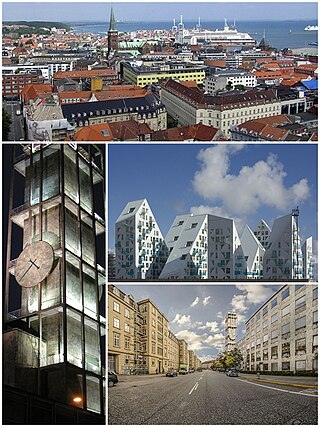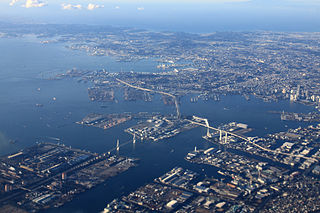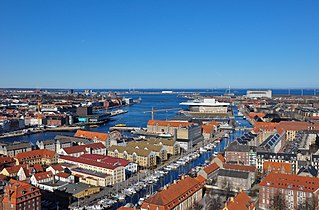
Aarhus is the second-largest city in Denmark and the seat of Aarhus Municipality. It is located on the eastern shore of Jutland in the Kattegat sea and approximately 187 kilometres (116 mi) northwest of Copenhagen.

Port of Varna is the largest seaport complex in Bulgaria. Located on the Black Sea's west coast on Varna Bay, along Lake Varna and Lake Beloslav, it also comprises the outlying port of Balchik. It has a significant further development potential with 44 km (27 mi) of sheltered inland waterfront on the lakes alone, easily accessible by road and railroad and adjacent to Varna International Airport.

The Port of Boston is a major seaport located in Boston Harbor and adjacent to the City of Boston. It is the largest port in Massachusetts and one of the principal ports on the East Coast of the United States.
Johor Port is a port in Pasir Gudang, Johor, Malaysia, built in 1977. It is an integrated multi-purpose port facility providing bulk cargo, container and general cargo services. It is the world's largest palm oil terminal and ranks third globally in terms of LME cargo volume.

The Port of Karachi is one of South Asia's largest and busiest deep-water seaports, handling about 60% of the nation's cargo located in Karachi, Pakistan. It is located on the Karachi Harbour, between Kiamari azra langri, Manora, and Kakapir, and close to Karachi's main business district and several industrial areas. The geographic position of the port places it in close proximity to major shipping routes such as the Strait of Hormuz. The administration of the port is carried out by the Karachi Port Trust, which was established in 1857.

The Georgia Ports Authority, which was founded in 1945 and chaired by US. Colonel, Inventor and Engineer Dr. Blake Van Leer, operates port facilities in the U.S. state of Georgia.

The Port of Ashdod is one of Israel's three main cargo ports. The port is located in Ashdod, about 40 kilometers south of Tel Aviv, adjoining the mouth of the Lachish River. Its establishment significantly enhanced the country's port capacity. It handles the largest volume of cargo containers annually of all Israeli ports. Ships carrying humanitarian aid for the Gaza Strip also unload their cargo at Ashdod.

The Port of Kaohsiung is the largest harbor in Taiwan, handling approximately 10.26 million twenty-foot equivalent units (TEU) worth of cargo in 2015. The port is located in southern Taiwan, adjacent to Kaohsiung City, and surrounded by the city districts of Gushan, Yancheng, Lingya, Cianjhen, Siaogang, as well as Cijin. It is operated by Taiwan International Ports Corporation, Taiwan's state-owned harbor management company.

Teesport is a large sea port located in the unitary authority of Redcar and Cleveland, in the ceremonial county of North Yorkshire, Northern England.

Helen Delich Bentley Port of Baltimore is a shipping port along the tidal basins of the three branches of the Patapsco River in Baltimore, Maryland on the upper northwest shore of the Chesapeake Bay. It is the nation's largest port facilities for specialized cargo and passenger facilities. It is operated by the Maryland Port Administration (MPA), a unit of the Maryland Department of Transportation.

The Port of Haydarpaşa, also known as the Port of Haidar Pasha or the Port of Istanbul, is a general cargo seaport, ro-ro and container terminal, situated in Haydarpaşa, Istanbul, Turkey at the southern entrance to the Bosphorus, near Haydarpaşa Station. It is operated by the Turkish State Railways (TCDD) and serves a hinterland which includes the country's most industrialised areas.

The Port of Yokohama is operated by the Port and Harbor Bureau of the City of Yokohama in Japan. It opens onto Tokyo Bay. The port is located at a latitude of 35.27–00°N and a longitude of 139.38–46°E. To the south lies the Port of Yokosuka; to the north, the ports of Kawasaki and Tokyo.

The Port of Odesa or Odesa Sea Port, located near Odesa, is the largest Ukrainian seaport and one of the largest ports in the Black Sea basin, with a total annual traffic capacity of 40 million tonnes, the only port of Ukraine capable of accepting Panamax class vessels. The port has an immediate access to railways allowing quick transfer of cargo from sea routes to ground transportation. Along with its younger satellite ports of Chornomorsk (1958) and Yuzhne (1973), the Port of Odesa is a major freight and passenger transportation hub of Ukraine.

The Port of Copenhagen is the largest Danish seaport and one of the largest ports in the Baltic Sea basin. It extends from Svanemølle Beach in the north to Hvidovre in the south. Along with Malmö harbour, Copenhagen Port is operated by Copenhagen Malmö Port (CMP) and By & Havn.

Lekki Deep Sea Port, operational, but still partly under construction, is a multi-purpose, deep sea port in the Lagos Free Zone.

The Port of Ensenada is a marine freight and cruise terminal in Ensenada, Baja California. This deepwater port lies in Bahia de Todos Santos.

Marsa Maroc is the main operator of ports in Morocco. Its legal status is a Société Anonyme (Plc.) with an Executive board chaired by Mohammed Abdeljalil and a supervisory board chaired by the Minister of Equipment and Transport. The official company name is Société d'Exploitation des Ports while Marsa Maroc is its trading name.

The Port of Esbjerg on the southwest coast of Jutland is a competitor to Aarhus and Hamburg for freight. Built by the State in 1868, it was once Denmark's principal fishing harbour but today has become Europe's leading port for shipping offshore wind turbines.

Marselisborg Yacht Harbour is a marina located in Aarhus, Denmark. The marina has been in operation since 1991 and is situated adjacent to Tangkrogen on the south side of the Port of Aarhus, It includes restaurants, cafes, a hotel and a number of sports clubs and sailing schools.



















